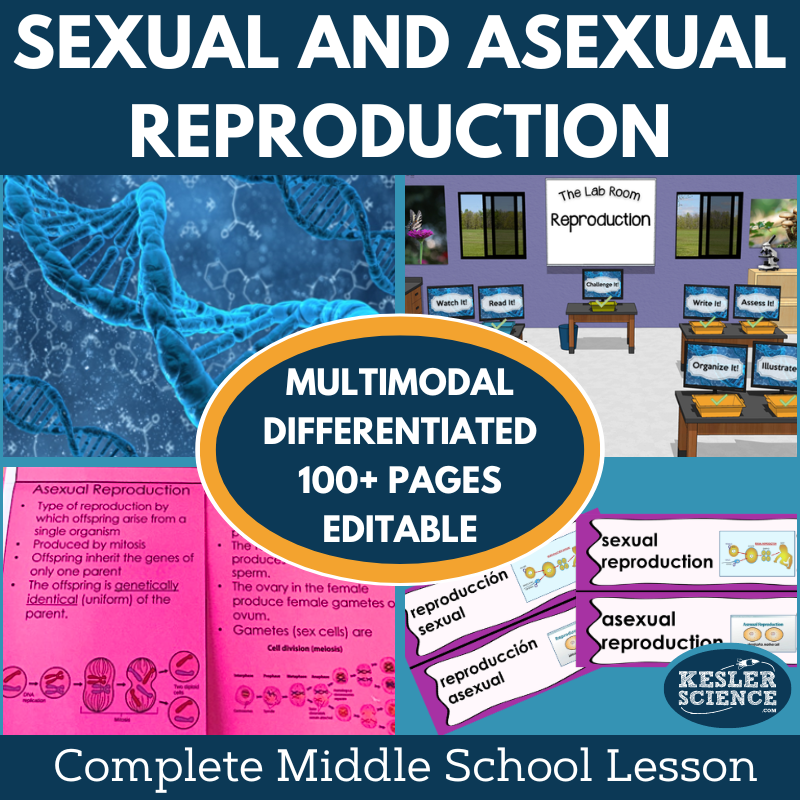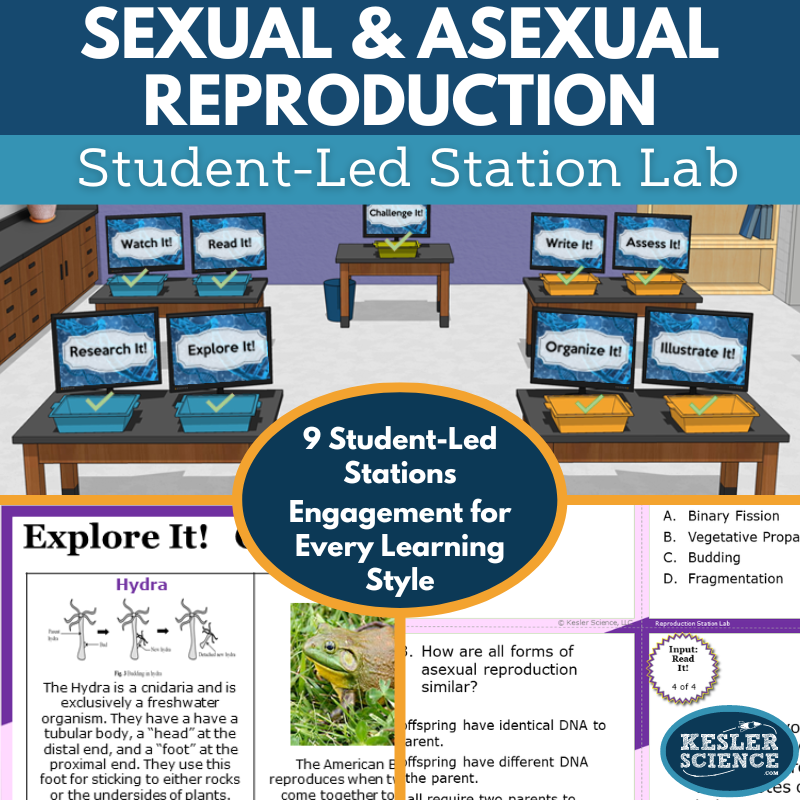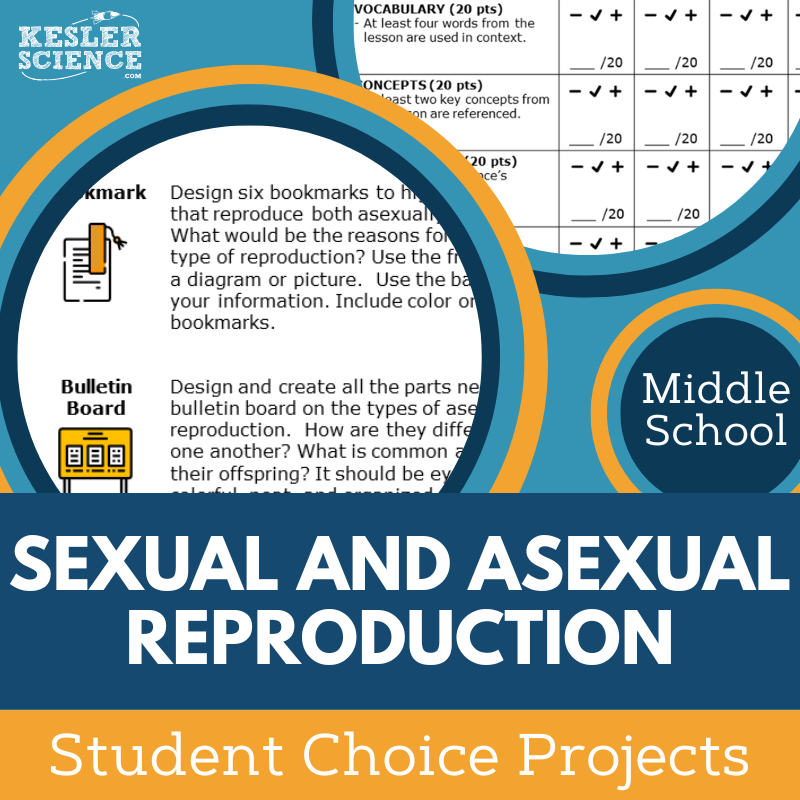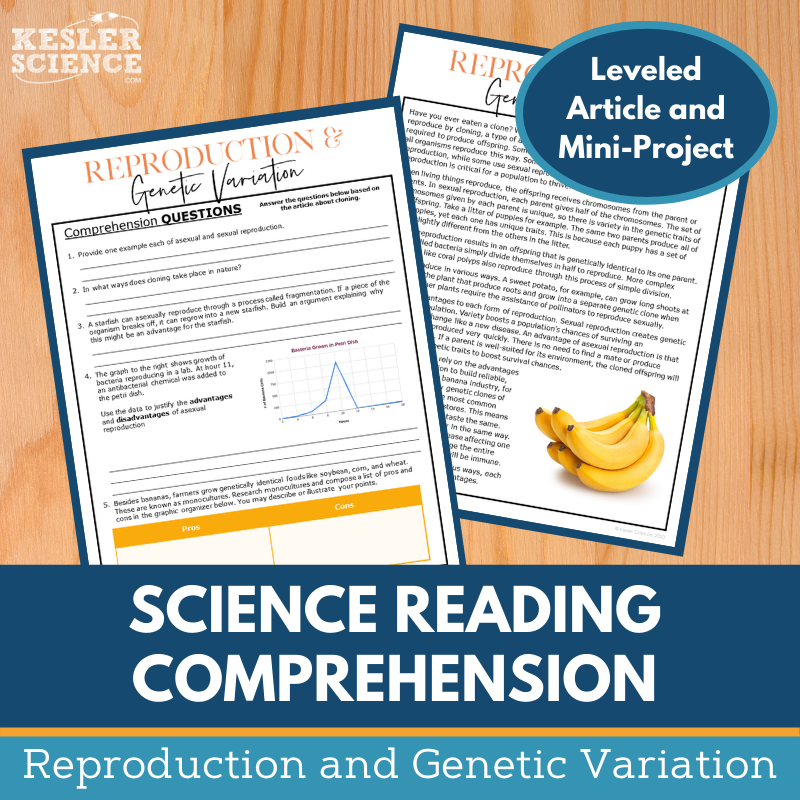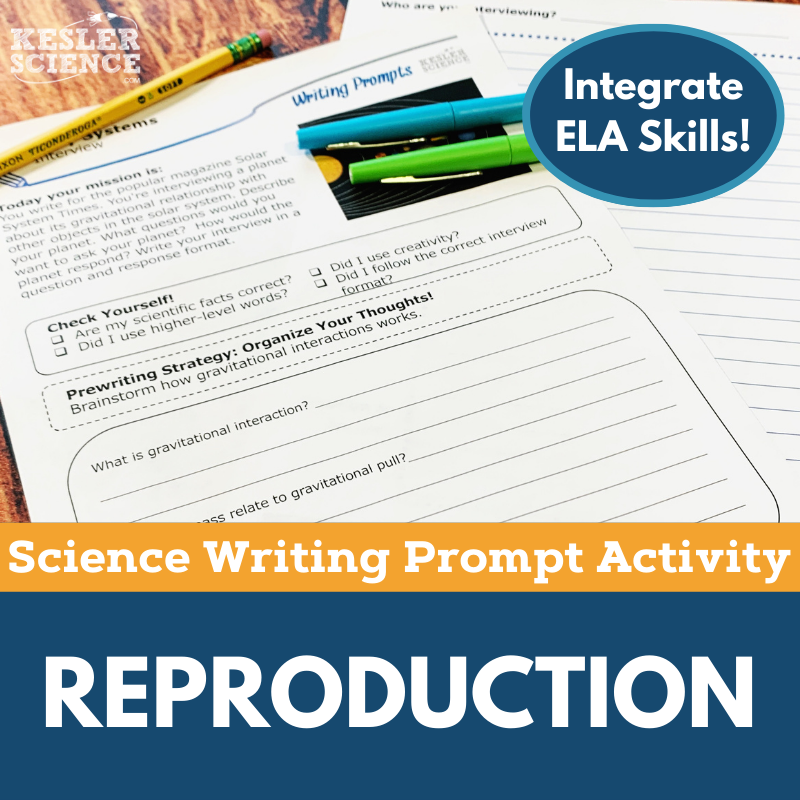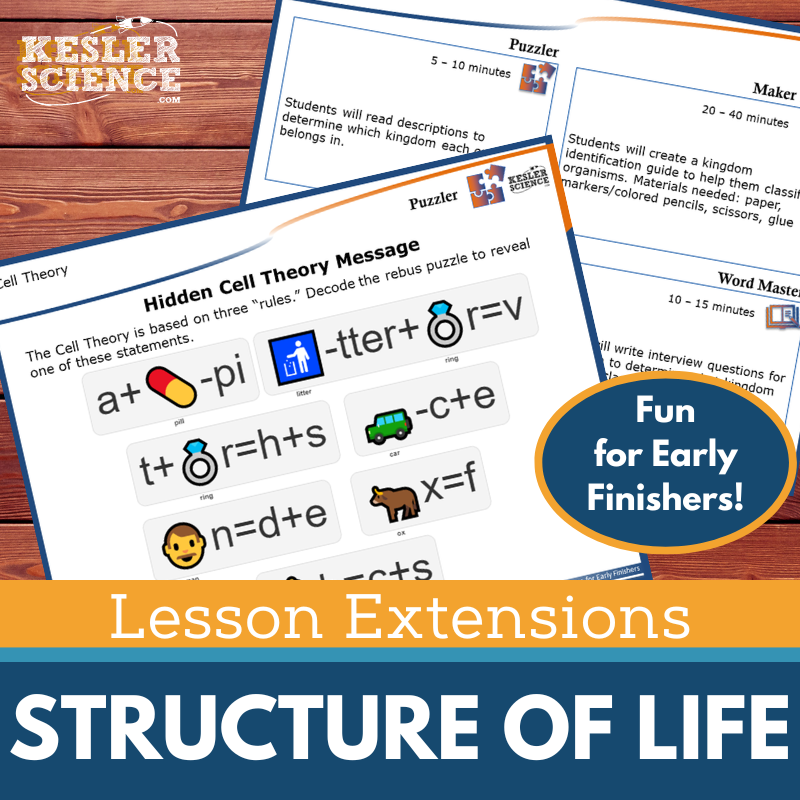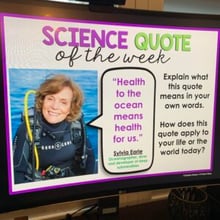Models for Genetic Variation Activities for Middle School Science
This engaging 5E lesson on sexual and asexual reproduction helps middle school students explore key concepts through interactive and student-led learning. The resources below will give students a comprehensive understanding of models for genetic variation. All of the following materials are also included in the Kesler Science Membership.
The Kesler Science Sexual and Asexual Reproduction 5E Lesson is a comprehensive unit designed for middle school students, incorporating presentations, worksheets, choice projects, and assessments. Fully editable and requiring minimal prep, the lesson supports differentiated, student-led learning, allowing teachers to focus on student success. Students explore key questions about reproduction, including comparisons between sexual and asexual reproduction, how different types produce uniform or diverse offspring, and how genetic information is inherited.
Following the 5E Model, the unit includes engagement activities with word wall cards and discussion prompts. Exploration features a student-led station lab with multimodal learning, including hands-on activities, reading passages in English and Spanish, research tasks, videos, and interactive sorting exercises. Explanation resources include editable PowerPoints, interactive notebooks, and note-taking templates. Elaboration provides student-choice projects, while evaluation includes STAAR-aligned assessments and review materials.
The lesson is flexible for in-person and virtual learning, with digital and printable formats. Spanish translations of vocabulary, reading passages, and interactive notebook pages support diverse learners.
The Kesler Science Sexual and Asexual Reproduction 5E Lesson is a comprehensive unit designed for middle school students, incorporating presentations, worksheets, choice projects, and assessments. Fully editable and requiring minimal prep, the lesson supports differentiated, student-led learning, allowing teachers to focus on student success. Students explore key questions about reproduction, including comparisons between sexual and asexual reproduction, how different types produce uniform or diverse offspring, and how genetic information is inherited.
Following the 5E Model, the unit includes engagement activities with word wall cards and discussion prompts. Exploration features a student-led station lab with multimodal learning, including hands-on activities, reading passages in English and Spanish, research tasks, videos, and interactive sorting exercises. Explanation resources include editable PowerPoints, interactive notebooks, and note-taking templates. Elaboration provides student-choice projects, while evaluation includes STAAR-aligned assessments and review materials.
The lesson is flexible for in-person and virtual learning, with digital and printable formats. Spanish translations of vocabulary, reading passages, and interactive notebook pages support diverse learners.
Engage your middle school students with this interactive, student-led station lab on sexual and asexual reproduction. Designed to promote independent learning, this structured activity allows students to explore and compare reproductive methods through hands-on and digital tasks.
Students engage with the topic through nine differentiated stations, each offering multimodal ways to learn. Input stations include hands-on demonstrations, online research, reading passages in English and Spanish, and video-based learning. Output stations provide opportunities for organizing information, illustrating concepts, writing responses, and completing assessments. A bonus challenge station offers extension activities like crosswords, games, and mini-projects for early finishers.
This flexible resource includes all necessary signage, literature, resources, and task cards, making it easy to implement in both in-person and virtual learning environments.
Engage your middle school students with this interactive, student-led station lab on sexual and asexual reproduction. Designed to promote independent learning, this structured activity allows students to explore and compare reproductive methods through hands-on and digital tasks.
Students engage with the topic through nine differentiated stations, each offering multimodal ways to learn. Input stations include hands-on demonstrations, online research, reading passages in English and Spanish, and video-based learning. Output stations provide opportunities for organizing information, illustrating concepts, writing responses, and completing assessments. A bonus challenge station offers extension activities like crosswords, games, and mini-projects for early finishers.
This flexible resource includes all necessary signage, literature, resources, and task cards, making it easy to implement in both in-person and virtual learning environments.
The Sexual and Asexual Reproduction Student Choice Projects lesson allows middle school students to select a project that aligns with their preferred output style. A project page outlines six student-led options plus a “design your own” project, with an editable rubric for teacher, peer, or self-assessment. These flexible, multimodal projects provide creative ways for students to demonstrate their understanding, and teachers can adjust the rubric to fit their grading needs.
Two versions of the project page support differentiation, with a modified version including three options tailored for students needing remediation. Advanced students can take on a combination of projects while using the same rubric. The projects require standard classroom supplies such as paper, markers, and scissors, with many options available for digital completion. Some crafting supplies may be helpful for model-building.
The Sexual and Asexual Reproduction Student Choice Projects lesson allows middle school students to select a project that aligns with their preferred output style. A project page outlines six student-led options plus a “design your own” project, with an editable rubric for teacher, peer, or self-assessment. These flexible, multimodal projects provide creative ways for students to demonstrate their understanding, and teachers can adjust the rubric to fit their grading needs.
Two versions of the project page support differentiation, with a modified version including three options tailored for students needing remediation. Advanced students can take on a combination of projects while using the same rubric. The projects require standard classroom supplies such as paper, markers, and scissors, with many options available for digital completion. Some crafting supplies may be helpful for model-building.
The Models for Genetic Variation Inquiry Lab aligns with NGSS MS-LS3-2, guiding students to develop models that explain genetic outcomes in asexual and sexual reproduction. Students engage in a hands-on or digital simulation to create a new school mascot, exploring how sexual reproduction leads to genetic diversity while asexual reproduction produces identical offspring.
This lab includes three differentiated versions—dependent, modified, and independent—catering to varying student needs. The print format involves group activities with colored counters and paper, while the digital version offers an interactive experience via Google Slides, requiring no materials.
Teachers benefit from editable resources, comprehension questions, Claim-Evidence-Reasoning prompts, and reflection sections. Answer keys, teacher guides, and flexible print and digital formats make this an engaging and adaptable lab for any classroom.
The Models for Genetic Variation Inquiry Lab aligns with NGSS MS-LS3-2, guiding students to develop models that explain genetic outcomes in asexual and sexual reproduction. Students engage in a hands-on or digital simulation to create a new school mascot, exploring how sexual reproduction leads to genetic diversity while asexual reproduction produces identical offspring.
This lab includes three differentiated versions—dependent, modified, and independent—catering to varying student needs. The print format involves group activities with colored counters and paper, while the digital version offers an interactive experience via Google Slides, requiring no materials.
Teachers benefit from editable resources, comprehension questions, Claim-Evidence-Reasoning prompts, and reflection sections. Answer keys, teacher guides, and flexible print and digital formats make this an engaging and adaptable lab for any classroom.
This Science Reading Comprehension Passage helps students explore asexual and sexual reproduction by examining how genetic information is passed to offspring. Through a nonfiction article on nature’s clones, students answer comprehension questions and explain how genetic variation aids survival by creating a model, comic strip, or recording.
Designed for middle school, this leveled passage supports science literacy and reading comprehension. It includes five to seven questions, a hands-on mini-project, and a Cornell notes template. The resource is suitable for in-class or virtual learning, making it ideal for sub plans, extra credit, ISS, or whole-class instruction. It fosters critical thinking, classroom discussions, and textual analysis while reinforcing key life science concepts.
This Science Reading Comprehension Passage helps students explore asexual and sexual reproduction by examining how genetic information is passed to offspring. Through a nonfiction article on nature’s clones, students answer comprehension questions and explain how genetic variation aids survival by creating a model, comic strip, or recording.
Designed for middle school, this leveled passage supports science literacy and reading comprehension. It includes five to seven questions, a hands-on mini-project, and a Cornell notes template. The resource is suitable for in-class or virtual learning, making it ideal for sub plans, extra credit, ISS, or whole-class instruction. It fosters critical thinking, classroom discussions, and textual analysis while reinforcing key life science concepts.
The Reproduction Science Writing Prompt Activity engages middle school students in a creative skit or drama to reinforce their understanding of life science. Aligned with MS LS3-2, this low-prep, student-centered activity supports science reasoning and exploration while enhancing writing skills. Designed for both in-person and virtual learning, it keeps students engaged beyond the classroom.
This resource includes teacher directions with an answer guide and rubrics, projection and print handouts, and a digital PowerPoint version for Google Slides. Students can use full-sized or half-sheet handouts with prompts, self-checks, and pre-writing strategies. Ideal for cross-curricular activities, pre-test assessments, student choice projects, early finisher enrichment, extra credit, make-up work, TELPAS samples, or differentiation, this writing prompt fosters creativity and science literacy. It can also be displayed on a bulletin board or compiled into student anthologies.
The Reproduction Science Writing Prompt Activity engages middle school students in a creative skit or drama to reinforce their understanding of life science. Aligned with MS LS3-2, this low-prep, student-centered activity supports science reasoning and exploration while enhancing writing skills. Designed for both in-person and virtual learning, it keeps students engaged beyond the classroom.
This resource includes teacher directions with an answer guide and rubrics, projection and print handouts, and a digital PowerPoint version for Google Slides. Students can use full-sized or half-sheet handouts with prompts, self-checks, and pre-writing strategies. Ideal for cross-curricular activities, pre-test assessments, student choice projects, early finisher enrichment, extra credit, make-up work, TELPAS samples, or differentiation, this writing prompt fosters creativity and science literacy. It can also be displayed on a bulletin board or compiled into student anthologies.
The WIKI Tickets© Structure of Life Set offers 24 formative assessments designed for 6th-8th grade science, providing flexible and engaging ways to check student understanding. Each topic is available in five formats: a full-screen projection version, three printable handout sizes, and an interactive digital version compatible with PowerPoint and Google Slides.
Aligned with NGSS and TEKS standards, these assessments cover essential life science topics such as cell function, heredity, reproduction, levels of cellular organization, and genetic mutations. A bonus table of contents file is included to show standard alignment. These WIKI Tickets© can be used for in-person or virtual learning, making them versatile for any classroom setting. Students can respond on paper, digitally, or in a remote 1:1 environment. Use them as exit tickets, bellringers, or quick checks to assess student progress effectively.
The WIKI Tickets© Structure of Life Set offers 24 formative assessments designed for 6th-8th grade science, providing flexible and engaging ways to check student understanding. Each topic is available in five formats: a full-screen projection version, three printable handout sizes, and an interactive digital version compatible with PowerPoint and Google Slides.
Aligned with NGSS and TEKS standards, these assessments cover essential life science topics such as cell function, heredity, reproduction, levels of cellular organization, and genetic mutations. A bonus table of contents file is included to show standard alignment. These WIKI Tickets© can be used for in-person or virtual learning, making them versatile for any classroom setting. Students can respond on paper, digitally, or in a remote 1:1 environment. Use them as exit tickets, bellringers, or quick checks to assess student progress effectively.
Lesson Extensions provide engaging, student-choice activities designed to challenge early finishers and deepen their understanding of life science concepts. These activities help reinforce critical thinking, creativity, and problem-solving while keeping students engaged with rigorous yet enjoyable learning opportunities. They are ideal for lesson wrap-ups, independent challenges, and filling downtime during testing.
Each extension includes four interactive components: Puzzler for problem-solving, Maker Space for hands-on STEAM activities, Tech Connection for digital demonstrations, and Word Master for creative writing. With teacher directions, answer keys, and both print and projection versions, these extensions support flexible learning and enrichment.
Covering topics such as artificial selection, body systems, cell functions, genetic variations, heredity, and natural selection, Lesson Extensions align with NGSS and TEKS science standards, ensuring meaningful connections to curriculum goals.
Lesson Extensions provide engaging, student-choice activities designed to challenge early finishers and deepen their understanding of life science concepts. These activities help reinforce critical thinking, creativity, and problem-solving while keeping students engaged with rigorous yet enjoyable learning opportunities. They are ideal for lesson wrap-ups, independent challenges, and filling downtime during testing.
Each extension includes four interactive components: Puzzler for problem-solving, Maker Space for hands-on STEAM activities, Tech Connection for digital demonstrations, and Word Master for creative writing. With teacher directions, answer keys, and both print and projection versions, these extensions support flexible learning and enrichment.
Covering topics such as artificial selection, body systems, cell functions, genetic variations, heredity, and natural selection, Lesson Extensions align with NGSS and TEKS science standards, ensuring meaningful connections to curriculum goals.
This NGSS-aligned Amazing Anchors lesson introduces and reinforces the concepts of asexual and sexual reproduction through real-world connections. It begins with an introductory reading focused on ocean animals, accompanied by comprehension and extension questions to engage students. An explanatory reading follows, breaking down different types of reproduction with additional questions to reinforce learning.
This no-prep resource includes teacher directions, answer keys, projection slides, editable digital versions for LMS platforms, and print-friendly full- and half-sheet handouts. It aligns with NGSS standard LS3-2 and is designed to bookend a main lesson, fitting well within the Engagement and Elaborate segments of a 5E lesson. A differentiated version provides sentence starters and language support for students who need assistance. Available in both print and digital formats, this lesson is ideal for in-person and distance learning.
This NGSS-aligned Amazing Anchors lesson introduces and reinforces the concepts of asexual and sexual reproduction through real-world connections. It begins with an introductory reading focused on ocean animals, accompanied by comprehension and extension questions to engage students. An explanatory reading follows, breaking down different types of reproduction with additional questions to reinforce learning.
This no-prep resource includes teacher directions, answer keys, projection slides, editable digital versions for LMS platforms, and print-friendly full- and half-sheet handouts. It aligns with NGSS standard LS3-2 and is designed to bookend a main lesson, fitting well within the Engagement and Elaborate segments of a 5E lesson. A differentiated version provides sentence starters and language support for students who need assistance. Available in both print and digital formats, this lesson is ideal for in-person and distance learning.
Year-Round Resources
These year-round activities will increase your students' understanding of many middle school science topics. All of these activities are also included in the Kesler Science Membership.
Visual Data & Graphing
You're not alone if your students struggle with understanding graphs, charts, and tables. It's a skill that takes an enormous amount of practice. This resource will help students build a strong foundation in analyzing data and creating their own data visualizations.
Bell Ringers and Warm-Ups
These middle school science bell ringers are an excellent way to engage your students as soon as they walk into your classroom. This comprehensive FULL YEAR resource includes everything you need to start off each science class with an interesting warm-up activity.
Review Board Games
Each game board has been carefully designed to keep students engaged. There are 10 different action spaces on each board and dozens of question cards. All of the actions are related to science concepts and keep the students motivated throughout the game.
Each game is ready to play. Simply print out the board and the cards and let the students enjoy reviewing nine different units.
Essential Questions and Standards
Below are the essential questions and standards associated with the lessons and activities included in the models for genetic variation unit. This topic is only one of more than 100 middle school science topics included in the Kesler Science Membership.
-
How are sexual and asexual reproduction comparable?
-
What types if reproduction produces uniform and diverse offspring?
-
How is genetic information passed from parents to offspring?
-
NGSS - MS-LS3-2 Models for Genetic Variation
Kesler Science Membership
Imagine never having to search for another middle school science lesson again. The membership gives you access to ALL of the Kesler Science products in one place (Yes, including everything above).
Say goodbye to long hours of lesson prep.

